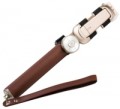Minimum length
The length of the monopod when folded. First of all, ease of transportation depends on this parameter, although a fully folded design can also be used when shooting. It is also worth mentioning that a smaller folded length (for the same maximum length) can mean more sections, which complicates the design, increases its cost and somewhat reduces reliability.
The most compact modern selfie sticks when folded take
less than 15 cm, the largest ones can have a minimum length of
more than 30 cm(this is an inevitable consequence of the large overall length).
Maximum length
The longest length that the monopod can be extended to.
Longer length allows you to place the camera further away from the user and fit more space into the frame. It can also be useful when shooting in hard-to-reach places where you can’t just reach with your hand. Also, with the same minimum length, a larger maximum length means a wider range of distances available for a given tripod. On the other hand, the working size of the structure significantly affects its weight and price.
If we talk about specific numbers, then the shortest modern selfie sticks are up
to 50 cm long. A value of
51 – 75 cm is considered average,
76 – 100 cm is more than average, and in the longest models they can expand to
1 m or more.
Number of sections
The number of separate sliding sections provided in the design of the tripod.
The more sections, with the same length, the shorter each individual section will be and the more compact the tripod will be when folded. On the other hand, an increase in the number of individual parts adversely affects the strength and reliability of the structure. When choosing the number of sections, manufacturers proceed from a compromise between these points; so long tripods tend to have more sections to keep them compact when folded.
It is also worth mentioning that in addition to multi-section
sliding selfie sticks,
fixed models are also produced, consisting of only one section. They are intended not so much for selfies, but for general convenience when shooting on a smartphone or action camera.
Fixed sections
The presence
of sections with special clamps in the design of the tripod.
The normal section for fixing in one position must be fully extended; this is not always convenient. The latches also allow you to fix the sections in any position, not necessarily fully extended. Thus, you can set almost any length of the rod (ranging from minimum to maximum). The disadvantages of such models are the high price and slightly increased weight.
Maximum load
Of course, you also need to take into account the weight of the case, box and other accessories installed on the gadget.
Most modern selfie tripods have a load capacity
of up to 0.5 kg, which seems modest, but for most smartphones and action cameras, more is not required.
0.5 – 1 kg is the average value, it is found mainly in models with the ability to install action cameras. Note that such a margin of safety already allows (with the necessary mounts) the use of classic cameras — compacts, many "mirrorless" and even some "reflex cameras" with relatively modest optics. And the most durable models can withstand more than more
than 1 kg ; this design can be useful both for a massive device and for a relatively light gadget — if you need a maximum margin of safety.
End thread
The presence
of a threaded socket in the design of the tripod.
Such a socket is usually located at the end, on the opposite side from the smartphone / camera mount. It can be used both for mounting various accessories (for example, a folding tripod for transformation into a tripod), and for mounting the rod itself on other structures (for example, a traditional photo tripod). The thread, usually, has a standard size, but this size still needs to be specified separately.
Shutter button
Method of linking the tripod-mounted shutter button to the mount-mounted camera.
—
Mini jack 3.5mm. Wired connection via a standard 3.5 mm mini-jack. This option is typical mainly for models compatible with smartphones (see "Intended Use") — almost all such gadgets have a mini-jack and, usually, when using a camera, it works as a control connector. The main advantage of tripods with a 3.5 mm plug is that they do not require a separate power supply; of the shortcomings, one can only note the very presence of a wire, which does not create any particular inconvenience, but not everyone likes it.
—
Bluetooth. Bluetooth wireless connection. Bluetooth modules are found in both smartphones and action cameras; and the absence of wires gives the design a neat appearance. In addition, this option allows you to use a tripod as a remote control even when the camera is placed outside the mount — the connection range is about 10 m. The disadvantage of Bluetooth, compared to a wired connection, is a higher cost, as well as the need for power, which limits battery life tripod.
—
Remote control. A separate remote control for the camera that comes with the kit is usually wireless, with a Bluetooth connection. Such a remote control is convenient in that it can be held in a convenient place — for example, in a free hand, without being distracted from holding t
...he monopod itself. At the same time, a mount for the remote control can be provided on the bar, and in some models it is duplicated by a built-in button (in case of loss of the remote control or dead batteries). And the most advanced remotes give access to various additional functions and may even have their own display. The disadvantages of this option are a rather high price and the need to monitor the battery status also in the remote control.